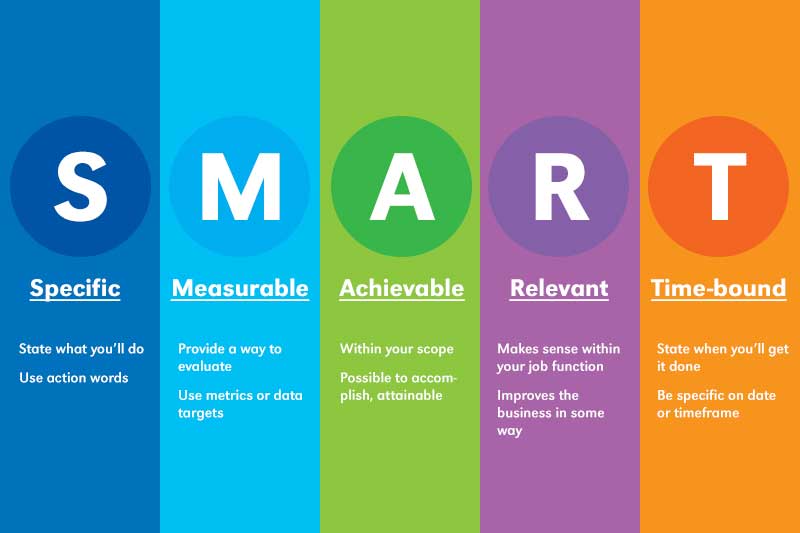Setting goals is no big deal, because it's what we do every day - many people think so, unfortunately wrongly. In both the private and business spheres, it is often the case that somehow the momentum is lost and halfway through we don't even know where we have started and why. This is because our goals are in fact vague ideas that are only partially defined or not defined at all. This is where the SMART method comes in, helping you to define your ideal and truly effective goals in 5 simple steps. In our article, we will discuss how.

The word SMART, which also means "smart", is in this case an acronym made up of the initials of English words. They form a set of criteria that help us to define our goals, create the focus we need for our work and make it easier to set tasks.
What are these "magic" criteria?
Criteria for a SMART target:
- Specific: specific, concrete
- Measurable: measurable, traceable
- Achievable / attainable / actionable: achievable / feasible / action oriented
- Relevant: relevant, important
- Time-related: time-limited
The origins of the SMART method
The Smart Method was originally the idea of George T. Daran from the pen of. Daran's aim was to provide managers with a simple, easy-to-use and easy-to-remember tool to help them set the right goals and detail how to achieve them. Although there is a wealth of literature on the subject, many managers do not know how to create good objectives.
How to set SMART goals?
Specific: the goal should be specific!
What exactly do we want to achieve? Let's define as many details as possible about our goal! For this criterion, the following questions should be answered.
- What is the project, product, product we are talking about?
- Who is affected by this target?
- In what areas do we need to work to achieve this?
Measurable: the measurability
For a SMART target, there are two basic things that need to be measurable. One is progress and the other is whether the goal has been met.
Measuring progress
Measuring progress is important to keep us on track, helps us stay on track and gives us the focus we need. To ensure accurate tracking, you can do the following:
- Let's set milestones! By breaking the bigger goal into smaller goals, small successes help to maintain motivation and give you a better idea of how much progress you are making
- Use task lists!
- We can introduce indicators, metrics, charts to illustrate progress: for example, the number of tasks completed in a week or the backlog chart
- It is very important to assess at regular intervals to keep track of where we are in reaching the target
Measuring the achievement of the target
It is essential to set up a set of criteria at the stage of defining the objective, which makes clear what conditions must be true for the objective to be considered achieved. Many people make the mistake of not knowing when they have achieved their goal and waste a lot of time doing so.
Achievable: choose a goal that you can achieve!
When setting goals, it is very important not to be completely out of touch with reality, so they should not be impossible to achieve.At the same time, they should be challenging, otherwise they will not motivate you and move you forward. The SMART goal should also be Actionable, so that achievement depends primarily on the steps taken to achieve it and not on external factors.
To do this, we need to know exactly:
- Our human/financial/asset/time resources
- The economic/social/legal etc. environment
Relevant: a SMART goal is important and fits in with our other goals
When choosing a target, it is essential to interpret it in context. If you are trying to achieve an organisational or business goal, check that you are not the only one who is interested in the goal. Does it fit in with the strategic objectives of the organisation and the other objectives of the project? Only then can we gain the support of the rest of the organisation or project team. And always set a personal goal that really motivates you and gives you pleasure.
To set a truly relevant target, it is worth considering the following questions:
- Will achieving the goal solve a real problem? Are we creating a real product?
- What needs are met to achieve this goal?
- Is it worth it?
- Is the timing right?
- Is it in line with economic and social trends?
Time-related: set a timeframe for implementation, set a deadline!
Many objectives are lost somewhere between "soon" and "someday". Unfortunately, this will not work! A defined timeframe is needed to identify and complete the right tasks at the right time. Moreover, without a timeframe, measuring progress is meaningless.

What else should you look for when setting and meeting a SMART target?
Get others involved!
It is worth discussing the above questions and aspects with others. When setting a business goal, it is essential to involve staff, other members of the project team, management and other stakeholders. This helps to narrow down the options and makes it clear to everyone what we are trying to achieve.
Let's be flexible!
Remember, nothing is set in stone! It is worth reviewing the target from time to time and refining it if necessary. Take into account the results of the indicators developed for measurability and rethink accordingly how to refine it!
Use tools that help you plan and monitor!
There are plenty of tools available to help us see what needs to be done and where we are. Here are a few options:
- Let's make a table! Even an Excel spreadsheet can be a very useful companion
- The WBS, or work breakdown structure, helps you see tasks and progress clearly
- A Gantt chart can be used to avoid bottlenecks and to visualise time
- In self-organising teams, the Kanban board increases the autonomy of the participants while at the same time giving the leader a constant overview of the process
SMART target in practice: an example of the method in action
The starting point should be a simple but very common management objective: "We want more efficient meetings in the future."
- Concretisation: By improving the presentation and negotiation skills of the team, faster, more efficient team meetings, fewer questions during meetings.
- Scalability: Our aim is to reduce the number of questions asked to 50%. Progress over the target period can be measured by measuring the number of questions on a continuous weekly basis
- Reality and activity-relatedness: We can train team members through online courses, coaching or workshops
- Relevance: It saves a lot of time if messages flow better, and it also helps us work together. And the professional development of team members is motivating and increases engagement.
- Duration: We have 6 months to reach the target. The first two months will be spent on online courses - training courses, after which workshops will be organised.
The precise objective will therefore be:
The aim is to improve the effectiveness of team meetings over 6 months through targeted development of presentation and negotiation skills. The target is met if the number of questions asked in meetings is reduced by 50%.
Learning and applying the SMART method is not only useful in business, but also in learning or for any other goal in our personal lives. We wish you good luck with its application!
Have a question? Contact us!
If you have any questions about more effective strategic planning or other areas of project management, please contact us. Contact us for a free consultation!

 Designabc
Designabc